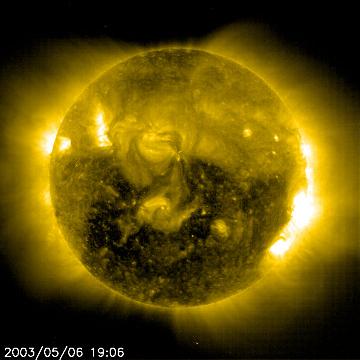Mammoth Coronal Hole (May 16, 2003)

Hi-res TIF image (3.2M)
|
The Sun's most striking feature for the last week was a mammoth coronal
hole that extended nearly half the face of the Sun for May 6-14, 2003.
The video clip shows the hole through May 11 as it rotates with the Sun
to where it begins to rotate out of view. Coronal holes appear as dark
areas of the corona when viewed in ultraviolet light and in X-rays.
This coronal hole area appears to be the largest seen in over year or
more. Coronal holes are the source of strong solar wind gusts that
carry solar particles out to our magnetosphere and beyond. Solar wind
streams take 2-3 days to travel from the Sun to Earth, and they are
more likely to affect Earth after they have rotated more than halfway
around the visible hemisphere of the Sun.
The magnetic field lines in a coronal hole open out into the solar wind rather than connecting to a nearby part of the Sun's surface. Always present at the poles of the Sun, coronal holes also occur closer to the solar equator, as we see here. These low-latitude coronal holes are responsible for the high-speed solar wind streams that sweep through the plane where the planets orbit -- and thus have a direct affect on "space weather" near the Earth. In fact, the Earth did feel the stronger and faster solar winds from this hole for several days after May 8 and numerous aurora displays were sighted. SOHO began its Weekly Pick some time after sending a weekly image or video clip to the American Museum of Natural History (Rose Center) in New York City. There, the SOHO Weekly Pick is displayed with some annotations on a large plasma display. If your institution would also like to receive the same Weekly Pick from us for display (usually in Photoshop or QuickTime format), please send your inquiry to steele.hill@gsfc.nasa.gov. |


